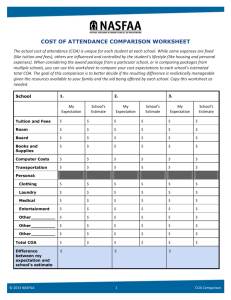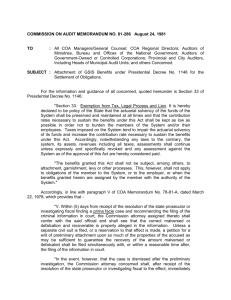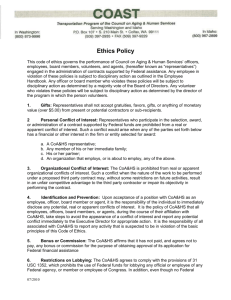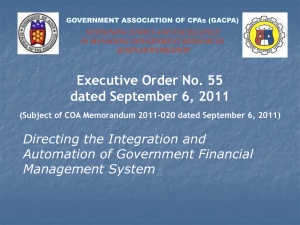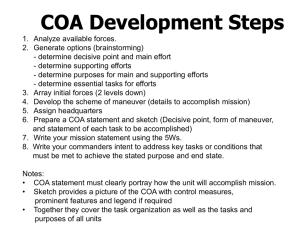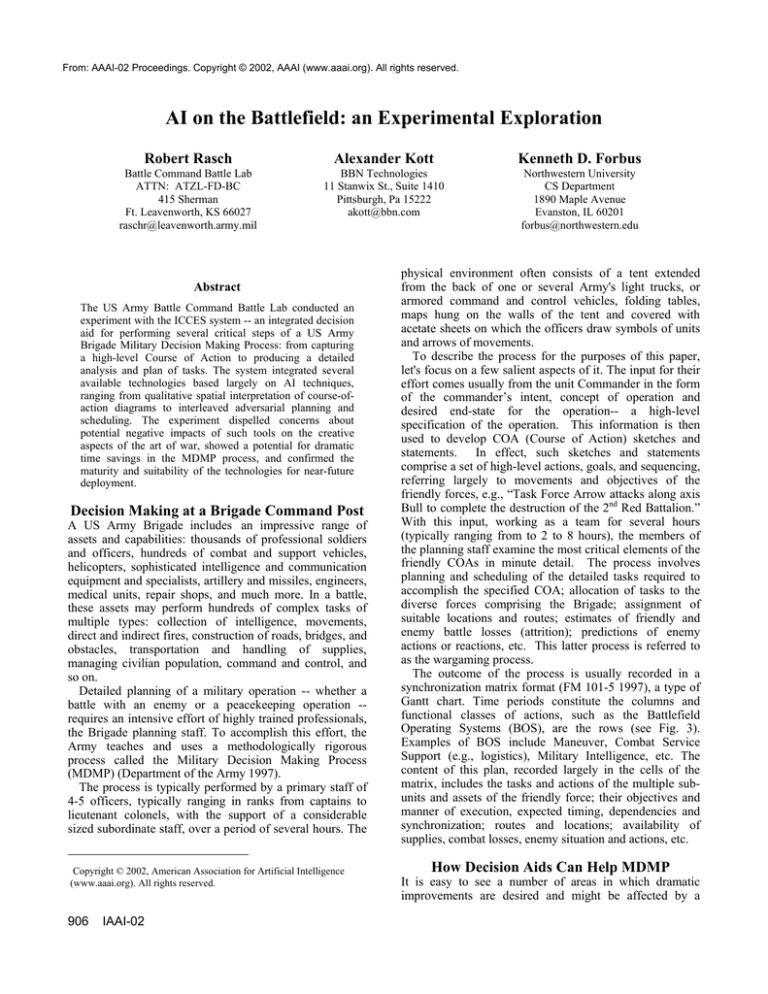
From: AAAI-02 Proceedings. Copyright © 2002, AAAI (www.aaai.org). All rights reserved.
AI on the Battlefield: an Experimental Exploration
Robert Rasch
Alexander Kott
Kenneth D. Forbus
Battle Command Battle Lab
ATTN: ATZL-FD-BC
415 Sherman
Ft. Leavenworth, KS 66027
raschr@leavenworth.army.mil
BBN Technologies
11 Stanwix St., Suite 1410
Pittsburgh, Pa 15222
akott@bbn.com
Northwestern University
CS Department
1890 Maple Avenue
Evanston, IL 60201
forbus@northwestern.edu
Abstract
The US Army Battle Command Battle Lab conducted an
experiment with the ICCES system -- an integrated decision
aid for performing several critical steps of a US Army
Brigade Military Decision Making Process: from capturing
a high-level Course of Action to producing a detailed
analysis and plan of tasks. The system integrated several
available technologies based largely on AI techniques,
ranging from qualitative spatial interpretation of course-ofaction diagrams to interleaved adversarial planning and
scheduling. The experiment dispelled concerns about
potential negative impacts of such tools on the creative
aspects of the art of war, showed a potential for dramatic
time savings in the MDMP process, and confirmed the
maturity and suitability of the technologies for near-future
deployment.
Decision Making at a Brigade Command Post
A US Army Brigade includes an impressive range of
assets and capabilities: thousands of professional soldiers
and officers, hundreds of combat and support vehicles,
helicopters, sophisticated intelligence and communication
equipment and specialists, artillery and missiles, engineers,
medical units, repair shops, and much more. In a battle,
these assets may perform hundreds of complex tasks of
multiple types: collection of intelligence, movements,
direct and indirect fires, construction of roads, bridges, and
obstacles, transportation and handling of supplies,
managing civilian population, command and control, and
so on.
Detailed planning of a military operation -- whether a
battle with an enemy or a peacekeeping operation -requires an intensive effort of highly trained professionals,
the Brigade planning staff. To accomplish this effort, the
Army teaches and uses a methodologically rigorous
process called the Military Decision Making Process
(MDMP) (Department of the Army 1997).
The process is typically performed by a primary staff of
4-5 officers, typically ranging in ranks from captains to
lieutenant colonels, with the support of a considerable
sized subordinate staff, over a period of several hours. The
Copyright © 2002, American Association for Artificial Intelligence
(www.aaai.org). All rights reserved.
906
IAAI-02
physical environment often consists of a tent extended
from the back of one or several Army's light trucks, or
armored command and control vehicles, folding tables,
maps hung on the walls of the tent and covered with
acetate sheets on which the officers draw symbols of units
and arrows of movements.
To describe the process for the purposes of this paper,
let's focus on a few salient aspects of it. The input for their
effort comes usually from the unit Commander in the form
of the commander’s intent, concept of operation and
desired end-state for the operation-- a high-level
specification of the operation. This information is then
used to develop COA (Course of Action) sketches and
statements. In effect, such sketches and statements
comprise a set of high-level actions, goals, and sequencing,
referring largely to movements and objectives of the
friendly forces, e.g., “Task Force Arrow attacks along axis
Bull to complete the destruction of the 2nd Red Battalion.”
With this input, working as a team for several hours
(typically ranging from to 2 to 8 hours), the members of
the planning staff examine the most critical elements of the
friendly COAs in minute detail. The process involves
planning and scheduling of the detailed tasks required to
accomplish the specified COA; allocation of tasks to the
diverse forces comprising the Brigade; assignment of
suitable locations and routes; estimates of friendly and
enemy battle losses (attrition); predictions of enemy
actions or reactions, etc. This latter process is referred to
as the wargaming process.
The outcome of the process is usually recorded in a
synchronization matrix format (FM 101-5 1997), a type of
Gantt chart. Time periods constitute the columns and
functional classes of actions, such as the Battlefield
Operating Systems (BOS), are the rows (see Fig. 3).
Examples of BOS include Maneuver, Combat Service
Support (e.g., logistics), Military Intelligence, etc. The
content of this plan, recorded largely in the cells of the
matrix, includes the tasks and actions of the multiple subunits and assets of the friendly force; their objectives and
manner of execution, expected timing, dependencies and
synchronization; routes and locations; availability of
supplies, combat losses, enemy situation and actions, etc.
How Decision Aids Can Help MDMP
It is easy to see a number of areas in which dramatic
improvements are desired and might be affected by a
judicious introduction of computer aids (Wass de Czege
and Biever 2001).
Currently, manual products cannot be reused
downstream in the process. Multiple re-entry of
information, hand-jamming, and just the fact of creating
multiple overlays take time. Even when the products are
produced in an ostensibly “electronic” format, e.g., a
PowerPoint presentation, it is not a true digitization – it
lacks semantic content and cannot be readily reused in the
downstream processes and tools. Could a better set of
tools, capable of capturing the semantics of the digital
information, address this deficiency?
Remaining essentially manual, the current process is
time and manpower consuming (Bohman 1999, Paparone
2001). Much of this consumption of man-hours is directed
toward computational tasks such as logistics consumption,
time/space analysis, etc., which could be at least in theory
allocated to a computer aid.
The time demands of the manual process force the staff
into drastically limiting the number and diversity of
options they are able to explore and analyze (Banner
1997). Perhaps, an intelligent computer aid could explore a
greater range of options, enabling the staff to analyze more
possible options in the same amount of time, or possibly
conducting deeper analysis of the same number of options
that the current process allows.
The dichotomy of planning and execution remains
pervasive. The gulf separating the two is unacceptably
wide, and could be explained at least in part by the fact that
today’s planning process is far too slow to be merged
effectively into execution decision-making. If computer
aids make fast, real-time planning and re-planning
possible, would it enable a major step toward the
integration of planning and execution?
The Army’s corporate knowledge continuously evolves,
and the rate of this evolution and adaptation has increased
under the pressure of multiple factors: new militarypolitical realities, the threat of asymmetric warfare, and the
rise in operations other than conventional war, to name just
a few. The effective mechanisms for capture and
transmission of such knowledge are elusive. Could it be
that computer decision aids (which by necessity must
contain some of the warrior’s knowledge, continuously
updated) can become one of such mechanisms?
Fighting by the Book and by Numbers?
In spite of potential benefits of decision aids in MDMP,
their roles, limitations and concept of operations in military
environments are justifiably open to a number of serious
questions and concerns. These questions and concerns
include:
Will they inhibit agility and dynamics of command,
forcing greater reliance on slow and bureaucratic
processes, command-by-plan and reduced latitude afforded
to the tactical commanders?
Will such computer aids impose extensive training and
specialization requirements, turning warriors into narrowfocused computer tool operators?
Will they encourage excessive fixation on analytical
aspects of command, by the book and by numbers? And
detract from intuitive, adaptive, art-like aspects of the
military command decision making?
Will they engender undue dependence of future
commanders and staff on technology that may be
vulnerable in a combat environment? After all, isn’t it
often said with a great justification that “a map with a hole
in it is still a map, but a computer with a hole in it is a
doorstop?”
Will it make the plans and actions more predictable to
the enemy?
The Motivation and Focus of the
Experimental Exploration
Some of these questions and arguments can be clarified, if
not necessarily answered with opportunities and promise of
experimental investigation. That was the rationale behind
the Integrated Course of Action Critiquing and Elaboration
System (ICCES) experiment, conducted by the Battle
Command Battle Laboratory – Leavenworth (BCBL-L) as
a result of a TRADOC sponsored Concept
Experimentation Program (CEP) during the Government
fiscal year 2000. In this experiment, several promising and
representative prototype technologies were inexpensively
“lashed together” to produce a necessarily crude but
sufficiently useable suite of decision aids. The resulting
ICCES system was then placed in the hands of several
Army officers in controlled experiments. The key question
was: can such tools provide value to Army decisionmaking?
For the purposes of the ICCES experiment we focused
on the course of action planning and analysis steps of the
MDMP: from documenting and communicating a highlevel COA to producing a detailed analysis and plan of
tasks. A highly creative step of inventing a high-level
COA, currently explored by a number of researchers
(Hayes and Schlabach 1998, Atkin et al. 1999, Tate et al.
2001, Kewley and Embrecht) was left outside the scope of
this effort. To further circumscribe the scope of the
experiment (subject as always to budgetary constraints) we
focused on the planning process at the Army Brigade
echelon.
The Experimental Rig
To provide computer-aided support to the selected aspects
of MDMP, we identified several existing, advanced R&D
prototype tools, modified them lightly and integrated them
loosely and inexpensively into a conceptually seamless
suite of decision aids (Fig. 1). The resulting “rig” offered a
basis for conducting practical experiments structured
around the key tasks of the staff process.
COA Creator, developed by the Qualitative Reasoning
Group at Northwestern University, is a tool that allows a
user to sketch a COA into the computer (Ferguson et al.
2000). Although superficially similar to familiar drawing
tools like MS PowerPoint, COACreator is fundamentally
different in that there are semantic knowledge based
IAAI-02
907
representations stored into the computer for each item
added to the COA sketch. Additionally, this tool uses an
“overlay” approach to graphics which allows the user to
switch graphics on and off easily in a fashion which is
analogous to taking acetate graphics on and off a map,
which is the current practice. Finally, the system is
doctrinally based, to allow the military user to work in a
domain environment that is familiar to him. The tool is
also speech enabled, but for the purpose of the ICCES
experiment, the users used drag-and-drop functionalities
instead.
The COA statement tool, a product of Alphatech, Inc.,
was modified under the ICCES experiment to allow the
staff planner to enter the COA statement. Unlike a word
processor that captures words but not the semantics of the
text entered, this tool presented the users with an interface
that allowed them to produce natural language sentences to
construct their COA statement. Additionally, this system
was linked to the sketch tool to, in a sense, “auto-fill”
Figure 1 The architecture and process flow of
ICCES.
portions of the COA statement that could be derived
automatically from the sketch (e.g. units, tasks, etc.).
Some examples of the sentences that can be constructed
with the system are:
Close: TF 1-8, a mechanized infantry task force
(Supporting Effort 1) attacks to destroys REDARCAVBN2
in order to prevent REDINBN17 and REDARCAVBN2
from engages in offensive operations. Fires: Fires will
suppress OBJ CUB, then suppress OBJ ROYALS, then
suppress OBJ BRAVES, then suppress OBJ BREWERS.
The sketch and statement of today’s staff process during
COA development reflect different aspects of the course of
action. Although they go hand-in-hand, they each contain
some unique information that cannot be gleaned from the
other (“purpose” for example, cannot be easily inferred
from a COA sketch but is usually clearly defined in the
statement). These two distinct aspects also reflected
themselves in the fact that we had to use two different tools
908
IAAI-02
– COACreator and the COA statement tool – that capture
the content of the COA from two distinct prospective.
Thus, we needed a mechanism that could merge the digital
representations of sketch and statement in a unified product
– that was the task of the Fusion Engine. It was developed
by Teknowledge, Inc. and generated a single information
file from the two separate sources as well as eliminating
inconsistencies between the information. Additionally,
Teknowledge built an XML translator to translate the
knowledge fragments into the XML schema needed for the
next system in the experiment.
Once the digital representation of the sketch and
statement information is properly fused and translated, it
goes to the next tool called CADET, developed by
Carnegie Group, Inc. (now owned by BBN Technologies)
as an SBIR program, under the sponsorship of CECOM
RDEC. This tool transforms the sketch and statement into a
detailed plan/schedule of the operation. CADET expands
friendly tasks, determines the necessary supporting
relations, allocates/schedules tasks to friendly assets, takes
into account dependencies between tasks and availability
of assets, predicts enemy actions and reactions, devises
friendly counter-actions, estimates paths of movements,
timing requirements, logistics consumption, attrition and
risk. The resulting digital product can be then displayed in
a number of different forms – as a traditional
synchronization matrix or as an animated map. Although
the resulting plan still requires careful review and editing
by the planning cell officers, it was our expectation that it
could serve as a good starting point for further analysis by
the officers, and potentially a major time saver. A detailed
discussion of CADET is found in (Kott et al. 2002,
Ground, Kott and Budd 2002).
Once the COA is truly digitized, a tool like CADET can
automatically (or with human guidance) perform the
detailed planning, including the traditionally timeconsuming tasks such as time-distance analysis, logistics
calculations, and potential attrition calculations for the
plan.
These tools were linked together mainly via file transfer,
crudely but sufficient for exercising a carefully controlled
experiment. The overall “rig” supported a logical concept
of operation for the end-users, a group of staff planners:
- enter the COA sketch into the COA Creator, discuss and
modify (e.g., Fig. 2);
- enter the COA statement into the Statement Tool,
discuss and modify;
- review the detailed plan produced by CADET (e.g., Fig.
3), modify it as desired or return to the sketch and
statement to produce a new or modified COA;
- use the detailed plan product to generate the OPLAN/
OPORD.
Potentially, the entire process could be accomplished in
a few minutes (minus the manual generation of the textual
OPLAN/OPORD). However, only experiments could
determine whether it would work at all.
The Experiment
The experiment was conducted over a 3-day period and
involved eight Army officers (majors and lieutenant
colonels) at BCBL-L facilities in Fort Leavenworth,
Kansas. All the subjects were from combat arms branches
and had a variety of tactical experience, with 11-23 years
of Active Service. None of the users had prior technical
backgrounds, but all possessed basic computer skills with
MS Office products like PowerPoint, Word, etc.
The first day of the experiment consisted of training all
the officers on how to use the system. The training
consisted of walking the users through a complete scenario
of COA development (sketch and statement) and COA
expansion within the ICCES system.
The training
occurred over a 4-hour period and included a description of
each system within the experiment, and then a sample
COA was developed by the instructor with the students
following along on their own machine. Given limited
resources, the users worked in pairs during training, but
were each given opportunities to manipulate the software.
Observers noted the users performances, and at the end of
the training, the users were broken into two roughly
equivalent groups of four based on their tactical
skills/experience and their demonstrated technical skills
during the training.
On Day Two of the experiment, each group of four
officers conducted the MDMP process given a tactical
scenario. One group (control group) was to use the
traditional, manual process. The other group was to use
the ICCES system to conduct their planning. Each group
received the same plan and briefing from their simulated
higher headquarters, and both groups were allowed to ask
questions in order to ensure their understanding of the plan
(similar to how military units request additional
information in order to ensure their understanding of orders
from higher). Once the groups were confident in their
understanding of the high-level plan and their
requirements, they were allowed to organize and conduct
their planning activities. Each group was informed that
their deliverable products at the end of the day were three
COA sketches and statements, and one COA
synchronization matrix that reflected the one COA they
had chosen internally as their “best” COA with a level of
detail that would allow execution of the plan. The groups
were not given a specific time limit to complete their
planning, but observers monitored times for postexperiment analysis.
Day Three of the experiment would involve the same
procedures as Day Two, but the roles of the groups would
reverse. The control group assumed the role of the
automated group and vice-versa. The scenario was slightly
different, but similar enough to be comparable with the
Day Two scenario with regards to complexity of the plan,
etc. Both groups were tasked to provide the same products
as generated in Day 2 for the new scenario in their new
roles (automated or manual).
Although the experiment would provide valuable data
and insights into the issues of focus, there are several
considerations that prevent us from claiming statistical
relevance to our results. First, given the limited time
availability of the user groups, we were unable to conduct
enough iterations of the experiment to provide statistically
valid results. Second, although the groups were broken out
in order to attempt to achieve parity with regards to their
tactical and technical abilities, human factors such as
personalities could not be completely accounted for.
Finally, by switching roles of the groups from Day Two to
Day Three in the experiment, we introduced several other
uncontrollable variables into the experiment, such as team
Figure 2 The users entered the high-level COA
using the COA Creator tool.
building within the groups and the ability of the initial
control group to retain their training from Day One to Day
Three with regards to manipulating the software.
Observations and Lessons Learned
Significant observations began in the training phase. In
spite of a very modest time allocated to the training
session, users did not exhibit any hesitation or difficulties
in operating the system that could be attributed to a need
for additional training. This was all the more notable in
view of the fact that most of the training focused on the
workarounds necessitated by the limited integration of the
system. E.g., we had to train the users how to pass files
between the components of the system, how to avoid
crash-prone situation, etc. None of this should be necessary
in a mature, fully-developed system. Even with this
overhead, we were able to complete the training session in
four hours. Without the overhead, we estimate that the
training could be accomplished in less than an hour.
A key factor allowing the low training requirements and
rapid, easy learning curve was the use of a sketch-based
multimodal interface.
The nuSketch approach to
multimodal interfaces (Forbus et.al. 2001, 2002) used in
the COA Creator, like other multimodal interface systems
such as QuickSet (Cohen et.al 1997), exploits the
naturalness of drawing and visual annotations for
communicating with software. While QuickSet has shown
itself to be very useful, the nuSketch approach had several
advantages for this task over QuickSet. The QuickSet
IAAI-02
909
such as QuickSet (Cohen et.al 1997), exploits the
naturalness of drawing and visual annotations for
communicating with software. While QuickSet has shown
itself to be very useful, the nuSketch approach had several
advantages for this task over QuickSet. The QuickSet
approach focuses on providing recognition services as
interfaces to legacy computer systems; its “smarts” are in
statistical recognizers for visual symbols, speech and
natural language understanding, and integrating these
information sources into commands for the underlying
software system. By contrast, nuSketch-based systems
focus on rich conceptual understanding of the domain,
spatial reasoning about the user’s ink, and clever interface
design instead of recognition. These differences were
important for this task in several ways. First, the
conceptual understanding of the domain used in the COA
creator provided the representational framework needed for
CADET to do its work. Second, extensive pre-training of
speech vocabularies and grammars was not needed, as it
would be with QuickSet or any system using existing
speech recognition technology1. Instead, officers used the
software equivalent of push-buttons (organized in layerspecific glyph bars) to indicate the intended meaning of
their ink as they drew. This allows them to draw complex
shapes (which cannot be handled by today’s statistical
recognition technologies) and deal with interruptions such
Figure 3 A typical output - plan/schedule of a
brigade-sized offensive operation may include
hundreds of significant tasks. A fragment of such a
plan is shown here.
as conversations with fellow officers (which would cause
problems for most multimodal interfaces, which interpret
1
While speech recognition is useful in many applications,
today’s technology has severe limitations for battlefield
use, including sensitivity to environmental noise and
operator stress, user-specific training of the software, and
training operators to work with limited vocabularies and
grammars. Technology advances will change this over
time, but it is worth being wary about near-future
applications of speech recognition in battlefield systems.
910
IAAI-02
pauses or lifting the pen as a signal that what the person is
drawing is finished).
At the output side of the system, the users generally did
not express dissatisfaction with the quality of the planning
products generated with the ICCES system. The group that
used ICCES elected to make only a small number of
changes to the automatically generated product i.e., the
highly detailed synchronization matrix (Fig. 3). Only about
10-15 % of the entries in the matrix were manually edited,
indicating that the users were in agreement with the
overwhelming majority of the plan produced by ICCES.
After the editing, the products compared favorably with the
products produced by the control group. For example, the
COA’s produced by both groups when analyzed/wargamed
either through the ICCES system or manually, all resulted
in roughly the same estimates for time to complete the
mission and overall attrition of friendly forces. This
observation was later confirmed by a different experiment
reported in (Kott, Ground and Budd 2002) with regard to
the CADET module of ICCES, where a larger number of
test cases and multiple unbiased judges were used to
compare the products of manual and the computerized
processes.
Further, there was no evidence that the computerassisted process resulted in less imaginative, more cookbook type products. This can be simply explained by the
fact that the overall COA inputted into the system came
directly from the user and was not constrained in any way
by the software. By allowing the user to free-hand a COA
sketch into the system, there was complete freedom of
tactical actions for the user.
On the other hand, there were discouraging observations
with regard to the presentation aspect of the products.
Synchronization matrix is an accepted way of recording the
results of COA analysis. However, in the ICCES
experiment we found that the users had difficulties
comprehending the synchronization matrix generated by
the computer tool, even though it was presented in a very
conventional, presumably familiar manner. Perhaps, the
synchronization matrix functions well only as a mechanism
for short-hand recording of one’s own mental process.
However, the same synchronization matrix is not nearly as
useful when used to present the results of someone else’s,
e.g., a computer tool’s, reasoning process. In effect, the
synchronization matrix serves as a textual representation of
a visual process. The problem was further exacerbated by
the fact that ICCES-generated matrices were unusually
detailed and therefore large, making it difficult for the
users to navigate within this large volume of information.
It appeared a system like ICCES requires a qualitative
simulation/animation capability to visually present the
expanded plan to the user.
Another factor contributing to the low training
requirements appeared to be the intentionally simple,
straightforward process flow and the concept of usersystem interactions. These consisted of the sequence of
steps outlined earlier in section "The Experimental Rig,"
and the users readily accepted them as natural and
consistent with their prior training and experience in the
manual MDMP process.
In fact, the users displayed preferences for further
simplification of the process. For example, the users stated
that they would prefer a single process of entering sketch
and statement, rather than the two sequential steps that they
had to perform in ICCES. Their desire for a simple and
straightforward concept of operations was further
demonstrated in their use of the COA Statement tool – they
consistently looked and asked for one, simple way to enter
the statement, and shied away from the rich, flexible, but
necessarily complex approach offered by the tool. We will
return to this issue in the conclusions.
Consistent with the preference for a simple concept of
operations were the users' requests for a mechanism that
would allow them to perform easy modifications and
iterations within the process. In particular, the users wanted
to make changes in the synchronization matrix produced in
CADET and see it automatically reflected in the COA
sketch and statement. Although such a capability is
technically feasible to develop, the ICCES system did not
have it at the time of the experiment.
Of the greatest practical significance were those
observations that confirmed a potential for major reduction
in time and manpower required for performing a typical
MDMP cycle. In particular, the COA analysis/wargaming
process could potentially be shortened by several hours.
Significantly, the savings were realized primarily in the
downstream tasks, particularly in the step that generates a
detailed plan/schedule of the operation. This is hardly
surprising. The upstream processes of capturing the
digitized information, such as was done in our experiment
in the COA Creator tool, may not be any less timeconsuming than a manual counterpart. However, once the
information is captured in a digitized form, great timesavings accrue in the downstream processes. To put it
differently, none of the ICCES components alone can
deliver time-savings; but a system of such components can.
Conclusions
This study suggests evidence for several important
conclusions. To start with, AI techniques can be used to
create natural sketch-based interfaces that domain experts
can use with little training. The nuSketch approach to
multimodal interfaces, with its emphasis on visual
understanding of the user’s ink tied to a rich conceptual
understanding of the domain, provides a practical method
of expressing COA sketches with today’s technology.
One important limitation noted was the desire expressed
for a single tool that captures COA sketches and statements
simultaneously. This approach could be extended to
provide a unified map-based interface to do both tasks, but
it would require additional research to apply advances in
natural language understanding and dialogue management
to supply this capability. Another research opportunity is
to use the rich representations in the COA Creator as inputs
to other support tools, such as critiquers and pattern
completion (for hypotheses about Red intent) and access to
previous plans via analogy (Forbus, 2001).
Such
capabilities could be incrementally added to near-future
deployed systems as they became available, given a stable
semantic framework.
With a semantically-rich input provided by a tool like
the COA Creator, techniques of tightly interleaved
adversarial planning and scheduling, such as those applied
in the CADET component of ICCES, can be used to create
thoroughly detailed plans comparable in quality to
manually generated, but dramatically faster. Decision aids
that combine both natural COA sketch interfaces and a
full-functionality COA expansion mechanism can indeed
contribute greatly into dramatic increase in speed and
agility of the staff planning process, potentially bringing it
into an integrated execution-planning cycle.
With regard to the concerns that decision aids of such
nature might adversely impact the creative aspects of art of
war, the experiment illustrated the fact that such a suite of
computer aids is merely a tool. No tool is a substitute for
training, doctrine and personal qualities of the decision
makers, and regardless of tools, it is ultimately up to the
decision-makers to define their approach and style of
decision making. Although tools do lead to changes in the
details and form of the process, the experiment offered no
evidence that the substantive aspects of the decision
making processes will be either inhibited or dictated by
any such tools. Different commanders and staffs, with
different styles, will use such tools to leverage their own
preferences and strengths.
Currently, there is no evidence that a tool like ICCES
would in any way increase predictability of the plans, or to
encourage cook-book approach. To the contrary, because it
allows the staff planners to explore rapidly a broader range
of possible COAs, including those that are more
unconventional and out-of-the-box, there is a potential for
such tools to encourage greater ingenuity, creativity and
adaptivity.
Overall, the experiment suggests that the ICCES concept
is a practical paradigm for a planning staff decision aid,
with near-future deployment potential. Staff officers would
have such a tool available on a rugged, light-weight, highly
portable device, such as a PDA, linked to other such
devices via tactical internet. The decision-aid tool, in
keeping with ICCES lessons, would be tightly integrated,
capable of producing complex operational plans and orders
rapidly and with minimal manual input, with simple,
straightforward and natural operation concept, easy to learn
and easy to use even in stressful field conditions. An
officer would use it routinely to perform planning of
tactical operations, to collaborate with others while on the
move and dispersed over the battlefield, to issue
operational plans and orders, and to monitor and modify
the plans as the operation is executed and the situation
evolves. Furthermore, as demonstrated in ICCES, the
current AI technology is not far from being directly
transitioned into a practical tool of such nature.
IAAI-02
911
Acknowledgements
The US Army CEP program, sponsored by TRADOC,
provided the funding for this work. LTC’s Eugene Stockel,
John Duquette, and Brooks Lyles from BCBL-L provided
valuable advice and guidance. Mr. Murray Burke
(DARPA) made invaluable contributions to the preparation
and execution of the experiment. Several of the tools used
in ICCES were developed with support by DARPA
through the High Performance Knowledge Bases and
Command Post of the Future programs.
References
Atkin, M. S., Westbrook, D. L., and Cohen, P. R. 1999.
Capture the Flag: Military simulation meets computer
games. In Proceedings of AAAI Spring Symposium Series
on AI and Computer Games, 1-5.
Banner, G. T. 1997. Decision Making - A Better Way,
Military Review, Headquarters, Department of the Army,
vol.LXXVII, no.5.
Bohman, W. E. 1999. STAFFSIM, An Interactive
Simulation for Rapid, Real Time Course of Action
Analysis by U.S. Army Brigade Staffs, Thesis, Naval
Postgraduate School, Monterey, CA.
Department of the Army 1997. Field Manual 101-5. Staff
Organization and Operations, Headquarters, Washington,
D.C.
Cohen, P. R., Johnston, M., McGee, D., Oviatt, S.,
Pittman, J., Smith, I., Chen, L., and Clow, J. 1997.
QuickSet: Multimodal interaction for distributed
applications. In Proceedings of the Fifth Annual
International Multimodal Conference (Multimedia '97),
Seattle, WA, ACM Press, pp 31-40.
Ferguson, R.W., Rasch, R.A., Turmel, W., and Forbus,
K.D. 2000. Qualitative Spatial Interpretation of Course-ofAction Diagrams. In Proceedings of the 14th International
Workshop on Qualitative Reasoning. Morelia, Mexico.
Forbus, K., Ferguson, R. and Usher, J. 2001. Towards a
computational model of sketching. In Proceedings of
IUI’01, January 14-17, 2001, Santa Fe, New Mexico.
Forbus, K. 2001. Exploring analogy in the large. In
Gentner, D., Holyoak, K., and Kokinov, B. eds., Analogy:
Perspectives from Cognitive Science. MIT Press.
Forbus, K. and Usher, J. 2002. Sketching for knowledge
capture: A progress report. In Proceedings of IUI'02, San
Francisco, California.
Ground, L., Kott, A., and Budd, R. 2002. A KnowledgeBased Tool for Planning of Military Operations: the
912
IAAI-02
Coalition Perspective. In Proceedings of the Second
International Conference on Knowledge Systems for
Coalition Operations, Toulouse, France.
Hayes, C. C., and Schlabach, J. L. 1998. FOX-GA: A
Planning Support Tool for assisting Military Planners in a
Dynamic and Uncertain Environment. In Integrating
Planning, Scheduling and Execution in Dynamic and
Uncertain Environments, R. Bergmann and A. Kott, eds.,
AAAI Press, Madison, Wisconsin.
Kewley, R. and Embrecht, M. 1998 Fuzzy-Genetic
Decision Optimization for Positioning of Military Combat
Units. In Proceedings SMC’98, pp. 3658 – 3664, 1998
IEEE International Conference on Systems, Man, and
Cybernetics, October 11-14, La Jolla, California
Kott, A., Ground, L., Budd, R., Rebbapragada, L., and
Langston, J. 2002. Toward Practical Knowledge-Based
Tools for Battle Planning and Scheduling. In Proceedings
of IAAI 2002 Conference, Edmonton, Alberta, Canada.
Paparone, C. R. 2001. US Army Decisionmaking: Past,
Present and Future, Military Review, Headquarters,
Department of the Army, vol.LXXXI, no.4.
Tate, A., Levine, J., Jarvis, P., and Dalton, J. 2000, Using
AI Planning Technology for Army Small Unit Operations.
In Proceedings of the Fifth International Conference on
Artificial Intelligence Planning Systems.
Wass de Czege, H. and Biever, J. D. 2001. Six Compelling
Ideas On the Road to a Future Army, Army Magazine,
Vol.51, No.2, pp. 43-48..

